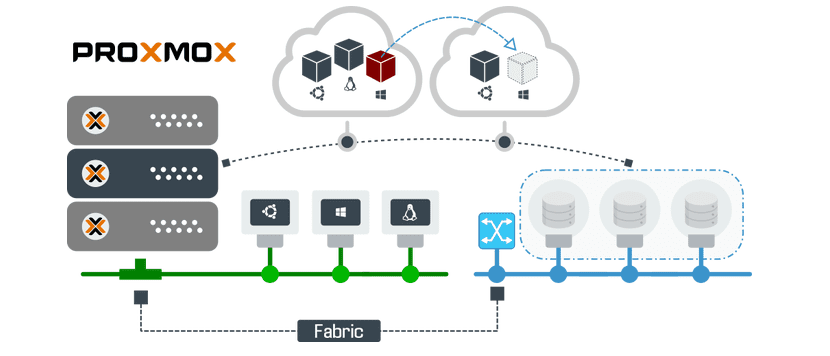
nextmox is a free virtualization management platform (AGPLv3) for manage KVM virtual machines and LXC containers. It is in GNU / Linux distributions based on Debian with a modified version of the RHEL Kernel and that allows the deployment and management of virtual machines and containers.
Proxmox VE includes a web console and command line tools and provides a REST API for third-party tools. Two types of virtualization are supported: LXC-based containers (from version 4.0 it replaces OpenVZ, used in version 3.4, inclusive), and virtualization with KVM.
Comes with an installer and includes a website based on the admin interface.
Proxmox VE 5.4 main features.
The new version of Proxmox VE 5.4 introduces a new wizard to install a Ceph cluster in the web interface, as well as more flexibility with high availability, hibernation support for virtual machines, and support for two-factor authentication (U2F).
Proxmox VE 5.4 it is based on Debian 9 Stretch and the Linux kernel 4.15.
New assistant Ceph
A new assistant allows the Ceph installation, available since 2014. Ceph's embedded storage technology comes with its own packages and support from the Proxmox team.
The creation of a Ceph server group was already available through the web administration interface.
Now with Proxmox VE 5.4, lThe developers have moved the Ceph installation from the command line to the user interface.
This enables users to configure the Proxmox VE / Ceph hyper-converged server cluster extremely quickly and easily.
In addition, companies with limited budgets can use standard hardware to reduce cost to increase the demand for storage.
On the other hand, this new version of Proxmox 5.4 comes with more flexibility and enhancements in high availability.

Proxmox VE 5.4 comes with new options to configure high availability policy across the entire data center, changing guest processing when a node is stopped or restarted.
This brings more flexibility and choice for the user. The new options are:
- Freeze: which always freezes services, whatever the type.
- Conmutation for mistake: never freeze services: means that a service will recover to another node, if possible, when the current node does not return in a minute
- Default, current behavior: freeze on reboot, but not on shutdown.
Hibernation
Hibernation for QEMU / KVM guests now supports Proxmox VE 5.4, users can hibernate QEMU guests regardless of their guest operating system and wake them up correctly on the next reboot.
Hibernation stores RAM content and internal state in permanent memory. This allows users to maintain the operational state of their QEMU guests during PVE node upgrades and reboots.
This speeds up the startup of guests running complex workloads, as well as workloads that are resource intensive during initial setup, but are released later.
Improved installation ISO images
The Proxmox VE installation wizard has been optimized and offers the ability to return to a previous screen during installation.
Users can adapt their options without having to restart the installation process. Before the actual installation, a summary page containing all relevant information will be displayed.
Security
As mentioned at the beginning, now U2F authentication is now supported in this new version of Proxmox 5.4, the Universal Second Factor (U2F) protocol can be used in the web interface as an additional two-step validation method for users.
As this is a must in certain areas and environments, it is therefore an important addition to safety practices.
Download and support
Proxmox VE 5.4 is now available for download on its website official. The link is this.
On the other hand, also this Proxmox Server Solutions offers business support starting at € 80 per year per processor.